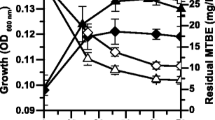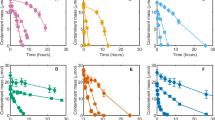Abstract
Degradation of methyl tert-butyl ether (MTBE) as a sole carbon and energy source was investigated utilizing an enriched bacterial consortium derived from an old environmental MTBE spill. This enriched culture grew on MTBE with concentration up to 500 mg/l, reducing the MTBE in medium to undetectable concentrations in 23 days. Traces of tert-butyl alcohol were detected during MTBE degradation. The degradation was not affected by additional cobalt ions, whereas low concentration of glucose enhanced the rate of degradation. The bacterial community consisted of numerous bacterial genera, the majority being members of the phylum Acidobacteria and genus Terrimonas. The alkane 1-monooxygenase (alk) gene was detected in this consortium. Our findings suggest that environmental degradation of MTBE proceeds along the previously proposed pathway.


Similar content being viewed by others
References
Altschul SF, Gish W, Miller W et al (1990) Basic local alignment search tool. J Mol Biol 215:403–410
Cho JC, Lee DH, Cho YH et al (1996) Direct extraction of DNA from soil for amplification of 16S rRNA gene sequences by polymerase chain reaction. J Microbiol 34:229–235
Dong MX, Ma Z, Chang K (2007) MTBE production and technology and market prospect analyse. Petrochem Ind Appl 26:6–9
Francois A, Mathis H, Godefroy D et al (2002) Biodegradation of methyl tert-butyl ether and other fuel oxygenates by a new strain, Mycobacterium austroafricanum IFP 2012. Appl Environ Microbiol 68:2754–2762
Goodfellow M, Jones AL, Maldonado LA et al (2004) Rhodococcus aetherivorans sp. nov., a new species that contains methyl t-butyl ether-degrading actinomycete. Syst Appl Microbiol 27:61–65
Hernandez-Perez G, Fayolle F, Vandecasteele JP (2001) Biodegradation of ethyl t-butyl ether (ETBE), methyl t-butyl ether (MTBE) and t-amyl methyl ether (TAME) by Gordonia terrae. Appl Microbiol Biotechnol 55:117–121
Jensen H, Arvin E (1990) Solubility and degradability of the gasoline additive MTBE, methyl tert-butyl ether and gasoline compounds in water. Contaminated Soil 90:445–448
Kane SR, Chakicherla AY, Chain PS et al (2007) Whole-genome analysis of the methyl tert-butyl ether-degrading beta-proteobacterium Methylibium petroleiphilum PM1. J Bacteriol 189:1931–1945
Lane DJ (1991) 16S/23S rRNA sequencing. In: Stackebrandt E, Goodfellow M (eds) Nucleic acid techniques in bacterial systematics. Wiley, Chichester, pp 115–175
Lopes Ferreira N, Malandain C, Fayolle-Guichard F (2006) Enzymes and genes involved in the aerobic biodegradation of methyl tert-butyl ether (MTBE). Appl Microbiol Biotechnol 72:252–262
Mo K, Lora CO, Wanken AE et al (1997) Biodegradation of methyl t-butyl ether by pure bacterial cultures. Appl Microbiol Biotechnol 47:69–72
Muller RH, Rohwerder T, Harms H (2008) Degradation of fuel oxygenates and their main intermediates by Aquincola tertiaricarbonis L108. Microbiology 154:1414–1421
Nadim F, Zack P, Hoag GE et al (2001) United States experience with gasoline additives. Energy Policy 29:1–5
Nakatsu CH, Hristova K, Hanada S et al (2006) Methylibium petroleiphilum gen. nov., sp. nov., a novel methyl tert-butyl ether-degrading methylotroph of the Betaproteobacteria. Int J Syst Evol Microbiol 56:983–989
Quaiser A, Ochsenreiter T, Lanz C et al (2003) Acidobacteria form a coherent but highly diverse group within the bacterial domain: evidence from environmental genomics. Mol Microbiol 50:563–575
Rohwerder T, Breuer U, Benndorf D et al (2006) The alkyl tert-butyl ether intermediate 2-hydroxyisobutyrate is degraded via a novel cobalamin-dependent mutase pathway. Appl Environ Microbiol 72:4128–4135
Salanitro JP, Diaz LA, Williams MP et al (1994) Isolation of a bacterial culture that degrades methyl t-butyl ether. Appl Environ Microbiol 60:2593–2596
Sambrook J, Russell DW (2002) Molecular cloning: a laboratory manual, vol 3. Cold Spring Harbor Laboratory Press, New York
Skinner KM, Martinez-Prado A, Hyman MR et al (2008) Pathway, inhibition and regulation of methyl tertiary butyl ether oxidation in a filamentous fungus, Graphium sp. Appl Microbiol Biotechnol 77:1359–1365
Smith CA, O’Reilly KT, Hyman MR (2003) Cometabolism of methyl tertiary butyl ether and gaseous n-alkanes by Pseudomonas mendocina KR-1 grown on C5 to C8 n-alkanes. Appl Environ Microbiol 69:7385–7394
Squillace PJ, Moran MJ, Lapham WW et al (1999) Volatile organic compounds in untreated ambient groundwater of the United States. Environ Sci Technol 33:4176–4187
Steffan RJ, McClay K, Vainberg S et al (1997) Biodegradation of the gasoline oxygenates methyl tert-butyl ether, ethyl tert-butyl ether, and tert-amyl methyl ether by propane-oxidizing bacteria. Appl Environ Microbiol 63:4216–4222
Steffan RJ, Vainberg S, Condee CW (2000) Biotreatment of MTBE with a new bacterial isolate. In: Wickramanayake GB, Gavaskar AR, Alleman BC et al (eds) Bioremediation and phytoremediation of chlorinated and recalcitrant compounds. Battelle Press, Columbus, OH
Thompson JD, Gibson TJ, Plewniak F et al (1997) The CLUSTAL_X windows interface: flexible strategies for multiple sequence alignment aided by quality analysis tools. Nucleic Acids Res 25:4876–4882
United States Environmental Protection Agency (2007) State actions banning MTBE (statewide). EPA420-B-07-013. EPA, Washington, DC
Vainberg S, McClay K, Masuda H et al (2006) Biodegradation of ether pollutants by Pseudonocardia sp. strain ENV478. Appl Environ Microbiol 72:5218–5224
Acknowledgments
We are grateful to Dr. Simon Rayner for critical reading of the manuscript, and Dr. Martin M. Larsen for analyzing the medium for cobalt. This work was supported by the National Natural Science Foundation of China (Grant No. 30570038), Knowledge Innovation Program of the Chinese Academy of Sciences (Grant No. KSCX2-YW-G-009), and by the European Commission (Project BIOTOOL, Grant No. GOCE-003998).
Author information
Authors and Affiliations
Corresponding author
Rights and permissions
About this article
Cite this article
Liu, H., Yan, J., Wang, Q. et al. Biodegradation of Methyl tert-Butyl Ether by Enriched Bacterial Culture. Curr Microbiol 59, 30–34 (2009). https://doi.org/10.1007/s00284-009-9391-1
Received:
Revised:
Accepted:
Published:
Issue Date:
DOI: https://doi.org/10.1007/s00284-009-9391-1




